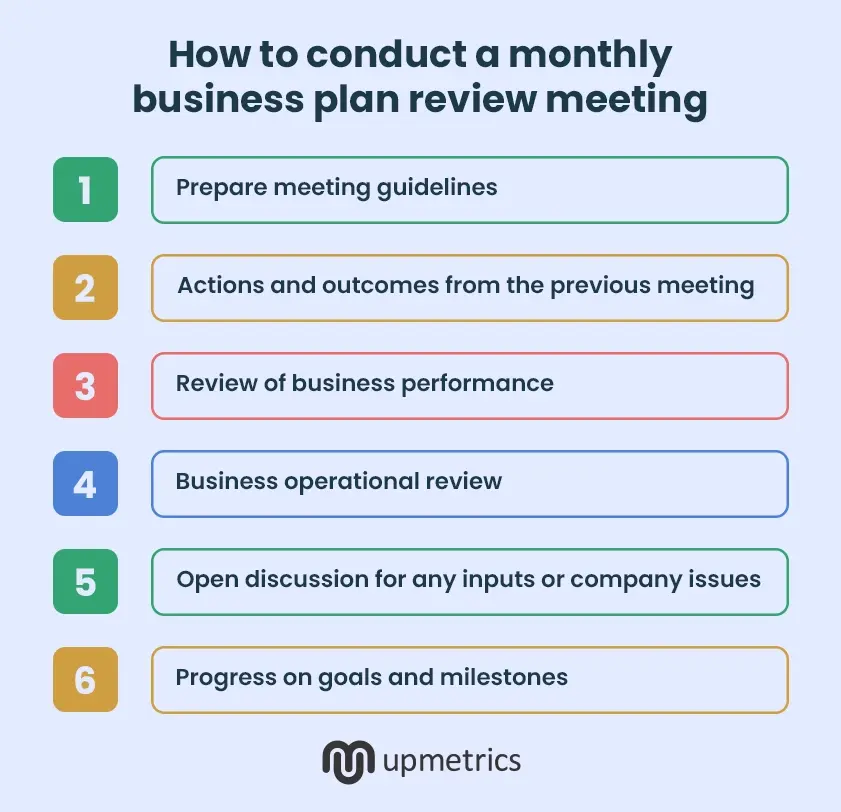When you and your team are on the everyday grind, it’s highly possible to lose track of progress. Sometimes you may even experience stagnation.
That’s when you need a savior, we call a monthly business plan review meeting.
A monthly business plan shows you the actual picture of where you stand and what needs to be done to fix the issues. Reviewing it monthly keeps you up to speed and ready to take on the competitive world month after month!
But the question is: How to conduct a monthly business review meeting?
Don’t worry, in this blog, we’ll tell you why you need such a meeting, how to conduct it, and share a free template so you can get a head start.
Let’s begin.
Key Takeaways
- Regular monthly reviews help track progress, identify challenges, and adjust strategies accordingly.
- Key steps include preparing meeting guidelines, reviewing past actions, assessing business performance, and discussing goals and milestones.
- Open discussions during these meetings foster team alignment and proactive problem-solving.
What is a monthly business plan review meeting?
A monthly business review is a meeting, conducted once a month, where your team gathers to review your current performance against your ideal performance or strategic plan.
The idea behind the meeting? Everyone should evaluate a month’s worth of journey and see if they’re still on track to achieve the strategic targets. If not, they can take necessary measures to keep up.
Why is it important to conduct a monthly plan review?
Here are three crucial benefits of conducting a monthly business plan review meeting:
1. Improves communication. Encourages reflection
In this meeting, all attendees dish out their progress and struggle openly. This does two things:
One, it improves communication, enabling transparency. As a result, your team can learn about the different challenges each one has faced and everyone can butt heads to find solutions.
Two, with everyone sharing their progress and backlogs, it creates the perfect space to reflect on business tasks and performances. In this process, your team can adjust
and re-prioritize anything and everything required to get back on the right track to meet the set business objectives.
2. Promotes accountability
With transparency and reflection comes a sense of accountability for all. The open discussions help employees feel responsible for every activity that brings the business closer to the ideal performance or stick to the strategic plan.
3. Enhances decision-making
By regularly reviewing your business plan, you get a front-row seat to insights that help you avoid costly mistakes or errors that can cause delays. But most importantly, you can identify what works and what doesn’t to make informed choices.
Regular meetings also give you the flexibility to pivot quickly as and when needed.
That said, let’s move on to…
How to conduct a monthly business plan review meeting
Here are some simple steps to follow to conduct a successful monthly business plan review:

1. Prepare meeting guidelines
There can’t be a meeting without knowing when and where it’ll happen, who will attend it, and what will be discussed. That’s why you need to start by preparing meeting guidelines.
Here’s everything you can include in your guidelines:
- Create calendar invites and send it out to participants
- Prepare an agenda so the meeting can start and end at the decided time and no items are undiscussed
- Asking team members to be ready with the numbers and questions (basically come prepared)
- Lay down the rules as to how and when people can share their inputs
2. Actions and outcomes from the previous meeting
This step comes in once the meeting begins. Unless it’s your first monthly business review ever, you have to go back in time and discuss the actions you took in the previous meeting or the results you obtained.
It could be that you had to analyze customer feedback to improve your product or that you introduced a similar feature as your competitor but did it better with a feature launch strategy.
The idea here is to ensure you’ve met all the goals intended for the previous month so you can focus on newer goals.
Once done, you can move on to…
3. Review of business performance
What’s a business review meeting without some business performance review? You can divide the performance based on two broad categories:
a) Reviewing your financial statements
Since it’s a monthly meeting you want to review monthly financial statements such as the income statement, balance sheet, and cash flow statement.
These statements will help you spot any financial anomalies and answer questions like:
- How did you do last month compared to your forecast?
- How did you do compared to the same month last year?
- What is the cash position and cash flow like?
- What does our cash flow forecast look like for the next few months?
You can even compare the actual performance against budgeted targets like revenue, expenses, and profit margins. As a result, you’ll gain insights into where:
- You need to pour in more funds
- There’s a loss
- There’s overspending
The bottom line: reviewing financial performances together will help you spot issues that you may not on your own.
b) Reviewing sales and marketing performance
Yes, it’s all about the money, but it’s also about what makes the money. So start by examining your sales and marketing performance.
Discuss how your actual sales numbers compare with the targets you had set for the month. Doing so should give you insight as to whether your sales funnel is benefiting you. For example how many leads have turned into customers? What stages are deals getting stuck in, and how can you address this?
All this data will tell your team where you stand and the strategies you must adopt to improve your sales game.
Coming to marketing, analyze your marketing campaigns’ effectiveness—meaning, check if the efforts translate into real business value. You can do so by discussing:
ROI (Return on Investment)
Calculate how much you spent for each campaign versus the revenue it generated. You want a high ROI (efficient marketing), rather than a low ROI which signals the need for improvement.
Customer acquisition costs (CAC)
Calculate how much it costs to acquire a single customer via different campaigns and channels—that’s CAC for you. Your aim should be to attain a low CAC to gain a good profit. See if you’ve met this criteria.
Lead quality and conversion rates
Are the leads generated by your campaigns converting into paying customers? If not, you must discuss how to rethink the campaign.
4. Progress on goals and milestones
Next, you want to review the progress toward achieving short-term and long-term strategic goals.
You can do so by identifying any gaps or delays and analyzing their root causes—whether it’s due to resource constraints, market shifts, or operational issues.
Once done, discuss if certain goals need adjustments or if strategies should need refining to ensure alignment with business priorities. This proactive evaluation helps to prevent future roadblocks and keeps the team focused on achievable outcomes.
In short: This step helps check if everyone is on track to meet the set goals so that the business stays aligned with its strategic objectives.
5. Business operational review
In the business operational review, assess any challenges that impacted efficiency over the past month, such as:
- Bottlenecks in production
- Delivery delays
- Staffing issues
- Technological issues
- Workflow process issues
- Supply chain issues
Discuss with your team how these were resolved the last time they occurred and collaborate to propose strategies to address them. You can do so by delegating tasks to fix issues and encouraging cross-departmental input.
This enables smoother operations to achieve business objectives.
6. Open discussion for any inputs or company issues
Lastly, you want to open the floor for anything and everything your team may want to discuss regarding your company. This can be regarding the work, operations, company issues, and obstacles employees are facing that prevent them from achieving set objectives.
That’s about it. You’ve successfully learned how to conduct a monthly business plan review meeting.
Monthly plan review meeting agenda (free template)
Are you ready to create your monthly business plan review agenda but need some guidance? We’ve got you covered! Download our free monthly business plan review plan template PDF and begin your journey now.
This template offers clear instructions and examples, helping you to build a strong and effective business plan meeting agenda. Plus, it’s customizable to suit your unique requirements.
Conclusion
Now that you know how to conduct a monthly business plan review meeting, your business won’t have to face many unforeseen, damaging, or delay-causing circumstances.
Just make sure you have a template in place so you don’t have to structure it every month. Instead, you can focus on the more important task, business review! And if you don’t already have a business plan in place. Don’t worry. Try business planning software like Upmetrics to create one in a jiffy.


